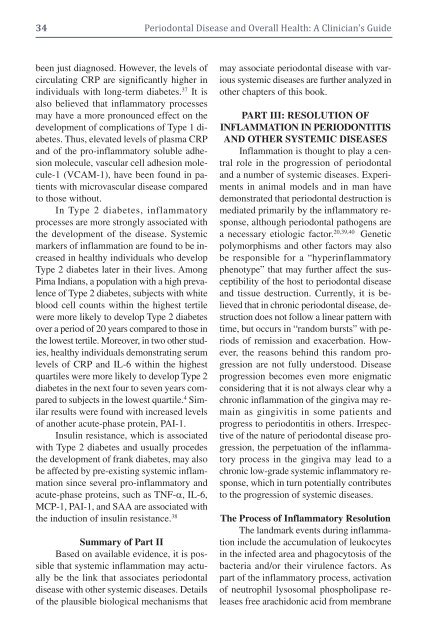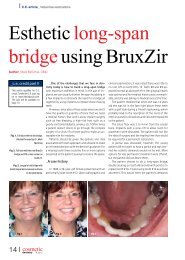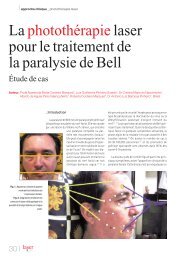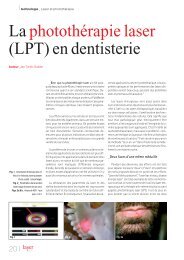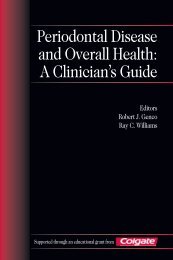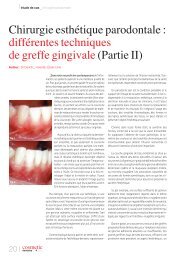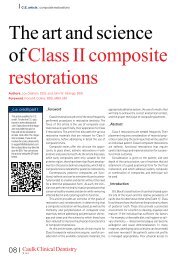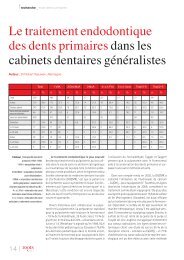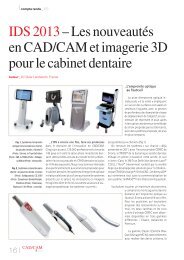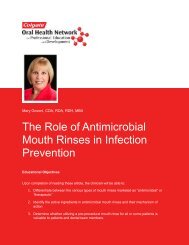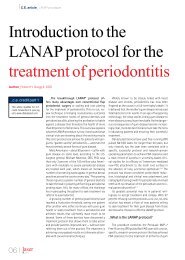Periodontal Disease and Overall Health: A Clinician's Guide
Periodontal Disease and Overall Health: A Clinician's Guide
Periodontal Disease and Overall Health: A Clinician's Guide
Create successful ePaper yourself
Turn your PDF publications into a flip-book with our unique Google optimized e-Paper software.
34 <strong>Periodontal</strong> <strong>Disease</strong> <strong>and</strong> <strong>Overall</strong> <strong>Health</strong>: A <strong>Clinician's</strong> <strong>Guide</strong>been just diagnosed. However, the levels ofcirculating CRP are significantly higher inindividuals with long-term diabetes. 37 It isalso believed that inflammatory processesmay have a more pronounced effect on thedevelopment of complications of Type 1 diabetes.Thus, elevated levels of plasma CRP<strong>and</strong> of the pro-inflammatory soluble adhesionmolecule, vascular cell adhesion molecule-1(VCAM-1), have been found in patientswith microvascular disease comparedto those without.In Type 2 diabetes, inflammatoryprocesses are more strongly associated withthe development of the disease. Systemicmarkers of inflammation are found to be increasedin healthy individuals who developType 2 diabetes later in their lives. AmongPima Indians, a population with a high prevalenceof Type 2 diabetes, subjects with whiteblood cell counts within the highest tertilewere more likely to develop Type 2 diabetesover a period of 20 years compared to those inthe lowest tertile. Moreover, in two other studies,healthy individuals demonstrating serumlevels of CRP <strong>and</strong> IL-6 within the highestquartiles were more likely to develop Type 2diabetes in the next four to seven years comparedto subjects in the lowest quartile. 4 Similarresults were found with increased levelsof another acute-phase protein, PAI-1.Insulin resistance, which is associatedwith Type 2 diabetes <strong>and</strong> usually procedesthe development of frank diabetes, may alsobe affected by pre-existing systemic inflammationsince several pro-inflammatory <strong>and</strong>acute-phase proteins, such as TNF-, IL-6,MCP-1, PAI-1, <strong>and</strong> SAA are associated withthe induction of insulin resistance. 38Summary of Part IIBased on available evidence, it is possiblethat systemic inflammation may actuallybe the link that associates periodontaldisease with other systemic diseases. Detailsof the plausible biological mechanisms thatmay associate periodontal disease with varioussystemic diseases are further analyzed inother chapters of this book.PART III: RESOLUTION OFINFLAMMATION IN PERIODONTITISAND OTHER SYSTEMIC DISEASESInflammation is thought to play a centralrole in the progression of periodontal<strong>and</strong> a number of systemic diseases. Experimentsin animal models <strong>and</strong> in man havedemonstrated that periodontal destruction ismediated primarily by the inflammatory response,although periodontal pathogens area necessary etiologic factor. 20,39,40 Geneticpolymorphisms <strong>and</strong> other factors may alsobe responsible for a “hyperinflammatoryphenotype” that may further affect the susceptibilityof the host to periodontal disease<strong>and</strong> tissue destruction. Currently, it is believedthat in chronic periodontal disease, destructiondoes not follow a linear pattern withtime, but occurs in “r<strong>and</strong>om bursts” with periodsof remission <strong>and</strong> exacerbation. However,the reasons behind this r<strong>and</strong>om progressionare not fully understood. <strong>Disease</strong>progression becomes even more enigmaticconsidering that it is not always clear why achronic inflammation of the gingiva may remainas gingivitis in some patients <strong>and</strong>progress to periodontitis in others. Irrespectiveof the nature of periodontal disease progression,the perpetuation of the inflammatoryprocess in the gingiva may lead to achronic low-grade systemic inflammatory response,which in turn potentially contributesto the progression of systemic diseases.The Process of Inflammatory ResolutionThe l<strong>and</strong>mark events during inflammationinclude the accumulation of leukocytesin the infected area <strong>and</strong> phagocytosis of thebacteria <strong>and</strong>/or their virulence factors. Aspart of the inflammatory process, activationof neutrophil lysosomal phospholipase releasesfree arachidonic acid from membrane


